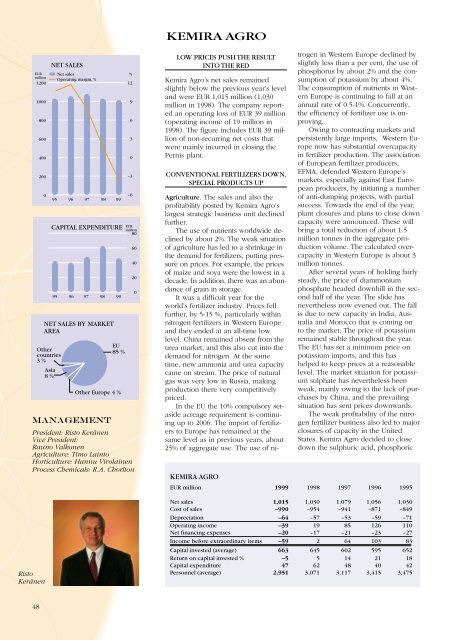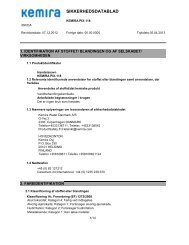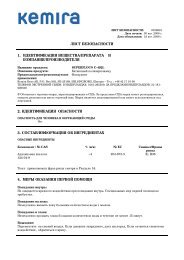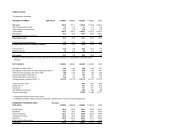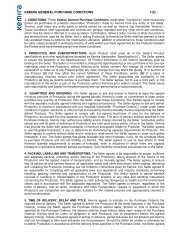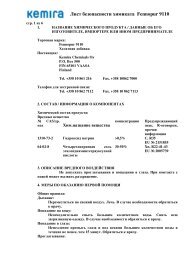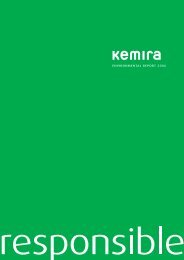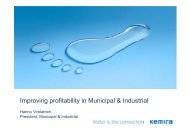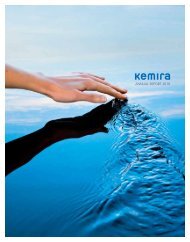Annual Report 1999 - Kemira
Annual Report 1999 - Kemira
Annual Report 1999 - Kemira
You also want an ePaper? Increase the reach of your titles
YUMPU automatically turns print PDFs into web optimized ePapers that Google loves.
KEMIRA AGRO<br />
EUR<br />
million<br />
1200<br />
1000<br />
800<br />
600<br />
400<br />
200<br />
0<br />
MANAGEMENT<br />
President: Risto Keränen<br />
Vice President:<br />
Rauno Valkonen<br />
Agriculture: Timo Lainto<br />
Horticulture: Hannu Virolainen<br />
Process Chemicals: R.A. Chorlton<br />
Risto<br />
Keränen<br />
NET SALES<br />
Net sales<br />
Operating margin, %<br />
95 96 97 98 99<br />
CAPITAL EXPENDITURE<br />
95 96 97 98 99<br />
NET SALES BY MARKET<br />
AREA<br />
Other<br />
countries<br />
3 %<br />
Asia<br />
8 %<br />
EU<br />
85 %<br />
Other Europe 4 %<br />
%<br />
12<br />
9<br />
6<br />
3<br />
0<br />
–3<br />
–6<br />
EUR<br />
million<br />
80<br />
60<br />
40<br />
20<br />
0<br />
LOW PRICES PUSH THE RESULT<br />
INTO THE RED<br />
<strong>Kemira</strong> Agro’s net sales remained<br />
slightly below the previous year’s level<br />
and were EUR 1,015 million (1,030<br />
million in 1998). The company reported<br />
an operating loss of EUR 39 million<br />
(operating income of 19 million in<br />
1998). The figure includes EUR 39 million<br />
of non-recurring net costs that<br />
were mainly incurred in closing the<br />
Pernis plant.<br />
CONVENTIONAL FERTILIZERS DOWN,<br />
SPECIAL PRODUCTS UP<br />
Agriculture. The sales and also the<br />
profitability posted by <strong>Kemira</strong> Agro’s<br />
largest strategic business unit declined<br />
further.<br />
The use of nutrients worldwide declined<br />
by about 2%. The weak situation<br />
of agriculture has led to a shrinkage in<br />
the demand for fertilizers, putting pressure<br />
on prices. For example, the prices<br />
of maize and soya were the lowest in a<br />
decade. In addition, there was an abundance<br />
of grain in storage.<br />
It was a difficult year for the<br />
world’s fertilizer industry. Prices fell<br />
further, by 5-15 %, particularly within<br />
nitrogen fertilizers in Western Europe<br />
and they ended at an all-time low<br />
level. China remained absent from the<br />
urea market, and this also cut into the<br />
demand for nitrogen. At the same<br />
time, new ammonia and urea capacity<br />
came on stream. The price of natural<br />
gas was very low in Russia, making<br />
production there very competitively<br />
priced.<br />
In the EU the 10% compulsory setaside<br />
acreage requirement is continuing<br />
up to 2006. The import of fertilizers<br />
to Europe has remained at the<br />
same level as in previous years, about<br />
25% of aggregate use. The use of nitrogen<br />
in Western Europe declined by<br />
slightly less than a per cent, the use of<br />
phosphorus by about 2% and the consumption<br />
of potassium by about 4%.<br />
The consumption of nutrients in Western<br />
Europe is continuing to fall at an<br />
annual rate of 0.5-1%. Concurrently,<br />
the efficiency of fertilizer use is improving.<br />
Owing to contracting markets and<br />
persistently large imports, Western Europe<br />
now has substantial overcapacity<br />
in fertilizer production. The association<br />
of European fertilizer producers,<br />
EFMA, defended Western Europe’s<br />
markets, especially against East European<br />
producers, by initiating a number<br />
of anti-dumping projects, with partial<br />
success. Towards the end of the year,<br />
plant closures and plans to close down<br />
capacity were announced. These will<br />
bring a total reduction of about 1.5<br />
million tonnes in the aggregate production<br />
volume. The calculated overcapacity<br />
in Western Europe is about 3<br />
million tonnes.<br />
After several years of holding fairly<br />
steady, the price of diammonium<br />
phosphate headed downhill in the second<br />
half of the year. The slide has<br />
nevertheless now evened out. The fall<br />
is due to new capacity in India, Australia<br />
and Morocco that is coming on<br />
to the market. The price of potassium<br />
remained stable throughout the year.<br />
The EU has set a minimum price on<br />
potassium imports, and this has<br />
helped to keep prices at a reasonable<br />
level. The market situation for potassium<br />
sulphate has nevertheless been<br />
weak, mainly owing to the lack of purchases<br />
by China, and the prevailing<br />
situation has sent prices downwards.<br />
The weak profitability of the nitrogen<br />
fertilizer business also led to major<br />
closures of capacity in the United<br />
States. <strong>Kemira</strong> Agro decided to close<br />
down the sulphuric acid, phosphoric<br />
KEMIRA AGRO<br />
EUR million <strong>1999</strong> 1998 1997 1996 1995<br />
Net sales 1,015 1,030 1,079 1,056 1,030<br />
Cost of sales –990 –954 –941 –871 –849<br />
Depreciation –64 –57 –53 –59 –71<br />
Operating income –39 19 85 126 110<br />
Net financing expenses –20 –17 –21 –23 –27<br />
Income before extraordinary items –59 2 64 103 83<br />
Capital invested (average) 663 645 602 595 652<br />
Return on capital invested % –5 5 14 21 18<br />
Capital expenditure 47 62 48 40 42<br />
Personnel (average) 2,951 3,071 3,117 3,415 3,475<br />
48


